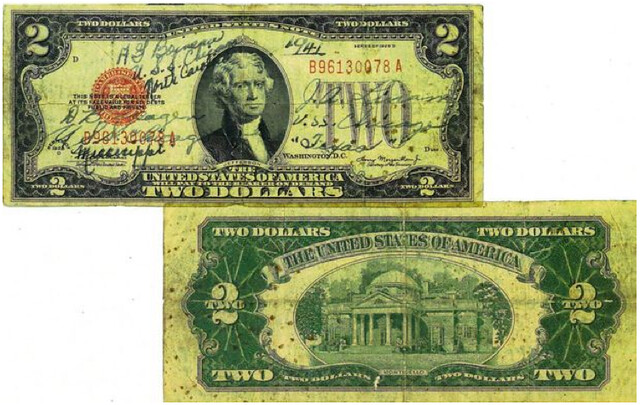
Heather McCabe runs a great website called Two Buckaroo, which is a running celebration of our most inconspicuous piece of currency: the $2 bill. The site primarily documents her experiences as she spends $2 bills and chronicles the reactions she gets — sometimes amused, sometimes annoyed, always interesting — from cashiers, bartenders, checkout clerks, and so on. But sometimes she'll also run posts under the heading "Twos in the News," rounding up recent news items relating to $2 bills. And one such news item that she recently found, although it dates back to last summer, is right in Permanent Record's wheelhouse.
Here's the deal: Thirty-some years ago, a Milwaukee woman named Nona Diamond acquired a 1928 $2 bill (see above), which she squirreled away in a safe deposit box. Last summer Diamond's daughter saw the bill for the first time and noticed that it was inscribed with the words "USS Chicago," "1941," and three signatures, one of which was legible — "Jesse Linam." She Googled the name and tracked down Mr. Linam, who was still alive at the age of 93. He had served on the USS Chicago during World War II, along with the other men whose signatures appear on the bill. He asked if he could have the bill back, and the Diamonds happily sent it to him.
Tracking currency as it moves in and out of people's lives is not a new phenomenon, of course. You may have seen $1 bills (or occasionally other denominations) stamped by people participating in the "Where's George?" project, which was founded in 1998 and uses serial numbers to track bills as they circulate around the nation (click to enlarge):

I've asked Heather — the $2 bill enthusiast — if she's considered something similar to "Where's George?" specifically for $2 bills, but she says she's not interested in tracking where the notes circulate. She's more interested in people's reactions to them and the stories that get told along the way. (For those who are interested in tracking $2 bills, some of them show up on "Where's George?")
Personally, I've never participated in "Where's George?" (it seems like a dangerously deep rabbit hole for someone as obsessive as I am), but I've always loved the idea of it. Pundits have been predicting a cashless society for decades now, but I'm hoping currency and coins stick around. They are, essentially, artifacts that we all get to share.

I'm with you in hoping that coins and currency hang around. As late as 2006 my mother provided me with a sleeve of newly minted nickels, which I haven't even opened. But I have alsways been drawn especially to coins for their enduring beauty, their feel in the hand, and their longevity. And as objects, they are so often lost - sunk at sea, buried and forgotten during a military campaign, or abandoned in a secret hiding place no sibling would ever think to look. Money may be the root of some evil, but it can also be a touchstone to connect us to our own times and to times before. I can remember doing rubbings of coins with paper and pencil; stacking and counting them; games we played with them on lunchroom tables; excited by a penny that was new, or steel, or a wheat penny. And I can share these artifacts with my daughetr when I find one now.
ReplyDeleteIs there any further reading you would recommend on this?
ReplyDeleteAmela
Nottingham Safesty Deposit Box